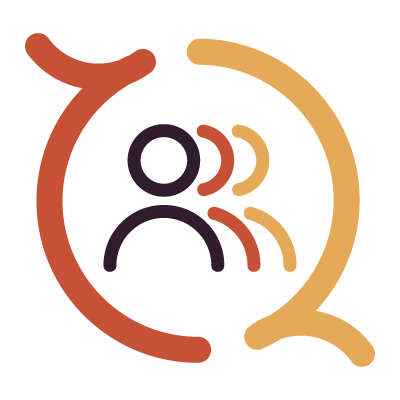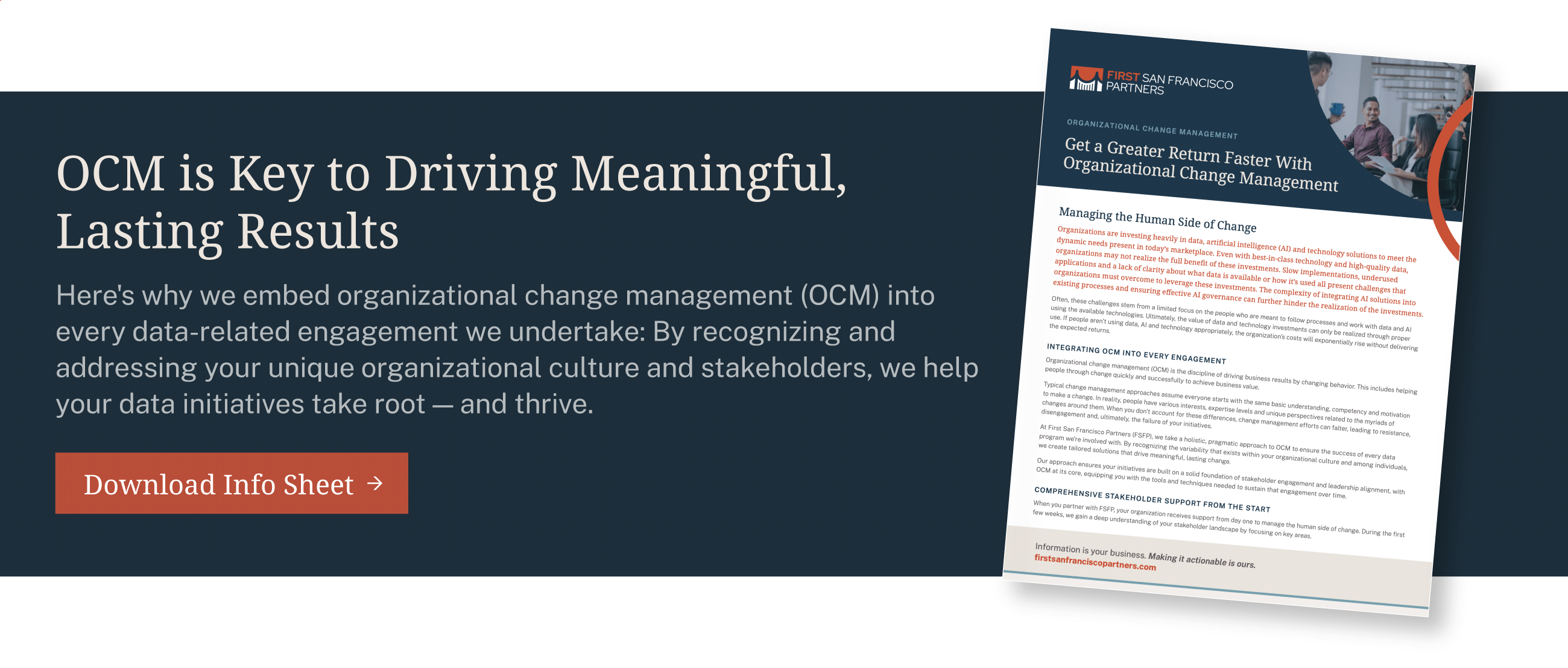Change is a natural part of life. Every day, it happens around us, motivating (or sometimes frustrating) us to adapt and keep up. I’m sure you’ve been on both sides of the change equation at work — asking people to change their behaviors or being asked to change yours.
If you manage or support a data management or governance program at your company, you’ll be on the asking side of change — probably, many times over.
Wouldn’t it be great if you knew how to inspire people to change the way they interact with your business’ data, welcoming new data-focused initiatives, tools and processes? If they could carry the “We need this change!” flag alongside you, it would make the change easier and long-lasting.
Getting people on board and excited about a new data governance (or similar) program is possible if you make change management an essential component of the initiative, focusing on the type of change, change management roles and how best to work through resistance.
Organization change management is never a one-person job.
Types of Change
There are a few ways to classify change. Focusing on scope and focus is a simple, easy way to break down what is changing and how people can get involved in the change.
Scope refers to how far a change will reach. If you’re dealing with an enterprise data governance tool everyone will use, the scope is broad. If you’re asking a single person or team to change how they handle their area’s data, the scope is narrower.
Assessing scope helps you better understand your role in communicating and encouraging change. In an organization-wide change, certain people you need to influence will get their directives and change messages from someone else, like a team lead or business head. Here, your job in communicating the change is to support the instructions others deliver. For a smaller-scale change, you may be the primary source of information.
Focus relates to what the change will affect and its benefits. For example, with a strategic change, you can talk about the collective benefits to individuals, departments and the organization. With a singular process-oriented change, you narrow your focus to an individual team’s benefits or the improved outcome of a revised process.
It’s helpful to know the type of change, too; here are some of the most common types:
- Strategic change affects how the organization is run or plans to move forward. This could mean changing products and services or fundamentally changing how business is done.
- Structural change is often related to an organizational structure redesign — i.e., the authority hierarchy, administrative procedures or management systems. For example, a new timekeeping system is a structural change because it replaces an existing system.
- Process-oriented change affects the way people do their work. Processes ensure accuracy, safety, efficiency, consistency, effectiveness or quality. Improving a process can improve outcomes in these areas. A new call-center application, for example, changes the processes used by phone representatives.
- People-centered change relates to employees’ attitudes, behaviors, skills or performance. An initiative to reshape company culture is a specific example of a people-centered change.
Resistance to change isn’t a bad thing. It’s how we’re wired.
Essential Roles in Change Management
Change management is never a one-person job. When you identify and fill key roles that support the change management element of your data management initiative, you’ll find strength in numbers. (Sidenote: The examples below show a singular person in the role, but you may need several people or a team, depending on the size of your organization.)
First, there’s the communicator who helps shape the compelling reasons for change, making messaging easy to understand and the change sound achievable. The communicator explains the consequences of what happens if a change isn’t adopted, doing so in ways that are non-threatening and most relatable to people.
When communicating change, repetition is important. Some change management experts say you should communicate a change seven times in seven different ways. A more reasonable way to think about frequency is this: When you get to the point where you feel you’re communicating too often, you’re communicating as often as you should be.
Your change management initiative needs an influential advocate to inspire people to adopt the change and identify external barriers, anything outside the employee, such as more training or new organizational expectations. If the change is related to a large program, the program’s executive sponsor is a logical choice of advocate for the change.
A change management coach can help people work through internal barriers that could obstruct change, such as lack of knowledge or skills or change-resistant attitudes. Every person is unique, and so are individual departments and lines of business. Coaching a broad group of people through change often requires diverse approaches.
Just as changes are inevitable in life, so is resistance to change. Your last role to consider is a resistance manager. Their responsibility is to help people identify and deal with what they are losing and gaining with the change.
There are many things people fear losing when they’re asked to change, such as familiar processes, resources, relationships, autonomy and job understanding. For example, team dynamics change when you hire a new employee, and people may be uncomfortable. On the positive side, the team gains capacity (someone to help share the workload), capabilities (the new person’s knowledge, skills and insights) and a refreshed team dynamic.
If people perceive the gain of capacity, capability and a new team dynamic to be greater than the discomfort of what’s lost, the change will be easier to accept.
The resistance manager will help people focus on the collective gains of a new data management or governance initiative instead of focusing on what they fear losing.
Make change management a part of your new data governance tool or other data-related initiative.
Working With Resistance
Resistance to change isn’t a bad thing. It’s how we’re wired. Resistance can be positive, even when it confronts and confounds us. It causes us to think more about the why and how of the change and the new initiative’s potential limitations and barriers.
Even though a data-related change may be unique to your business, there are universal best practices that you and your change management team (i.e., the roles I mentioned earlier) can take to address resistance:
- Communicate the change as early as possible – This must happen before resistance builds up. People need to hear about the change coming up, what’s involved (new procedures, tools, expectations, etc.) and the drivers and benefits of making the change. Remember that leaders and managers often hear about change before the rest of the organization does. They have time to process and discuss what will happen. When you don’t communicate early and broadly enough, you run the risk of people already knowing what’s in the works and beginning to worry about what it means to them.
- Recognize and accept resistance – Resistance happens with just about every change, so accept that this will happen and that it may not go away quickly. If you ignore resistance and don’t deal with it, it grows and becomes unmanageable.
- Don’t shoot the messenger – It’s critical people trust that their change leaders will help them address barriers in the way of adopting change. When you and your change team react calmly and rationally, showing interest in their concerns and being open to their input, you build trust.
- Identify reasons for resistance – Work with the person or team to determine why they’re resisting the change. Encourage them to identify what they believe they will lose — control, understanding, knowledge, familiarity or tools — so you can build a strategy to address the specific concern.
- Be empathetic – Ask people how they feel about the impending change. While you may not agree with what they say, put yourself in their shoes. Think about how you felt when you were asked to make a change. Recalling what you’ve been through will make you more empathetic.
- Make a plan to address resistance – Work with the individual or teams showing resistance to develop a plan that addresses their resistance. Ask for help or additional resources or tools if you’re at a loss on how to tackle certain forms of resistance. Part of your plan could be to find an advocate for the change among the people who are being affected, as it’s helpful to have change messages reinforced by a peer.
Change for the Better
Driving acceptance and adoption of a new data governance tool or another data-related initiative requires a concerted change management effort. If your organization needs a partner in the “change data for the better” journey, contact FSFP or email me. Change management is a passion of mine, and I bet we’ll have a lively conversation.




